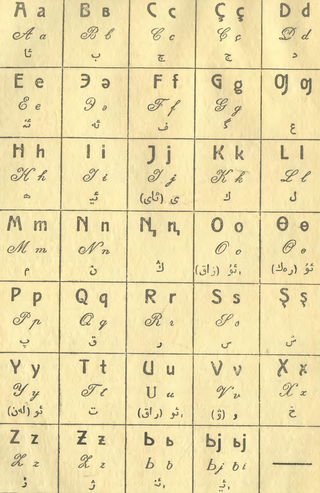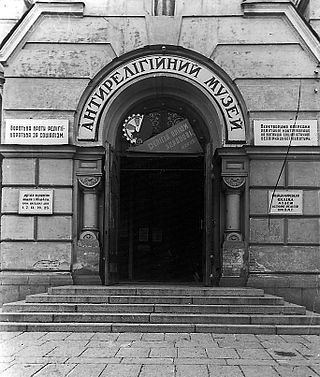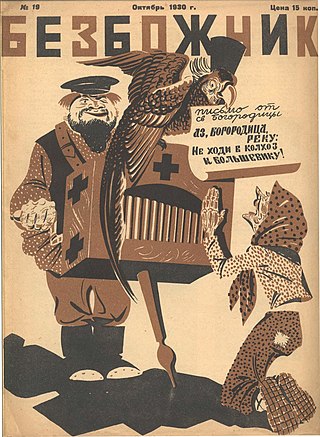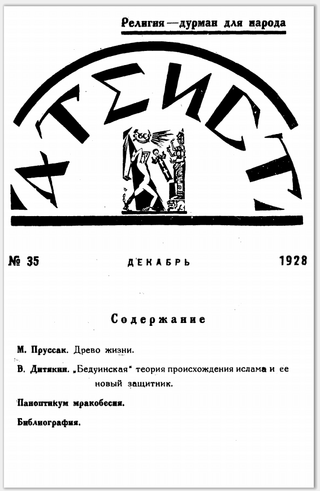
Islam is a major religious minority in the Russian Federation, which has the largest Muslim population in Europe excluding Turkey. According to the US Department of State in 2017, Muslims in Russia numbered 14 million or roughly 10% of the total population. One of the Grand Muftis of Russia, sheikh Rawil Gaynetdin, estimated the Muslim population of Russia at 25 million in 2018.

Jaꞑalif, Yangalif or Yañalif is the first Latin alphabet used during the latinisation in the Soviet Union in the 1930s for the Turkic languages. It replaced the Yaña imlâ Arabic script-based alphabet in 1928, and was replaced by the Cyrillic alphabet in 1938–1940. After their respective independence in 1991, several former Soviet states in Central Asia switched back to Latin script, with slight modifications to the original Jaꞑalif.

Islam in Lithuania, unlike many other northern and western European countries, has a long history starting from the 14th century. The medieval Grand Duchy of Lithuania of the Polish–Lithuanian Commonwealth, stretching from the Baltic to Black seas, included several Muslim lands in the south inhabited by Crimean Tatars. A few Muslims migrated to ethnically Lithuanian lands, now the current Republic of Lithuania, mainly during the rule of Grand Duke Vytautas. The Tatars, now referred to as Lithuanian Tatars, lost their language over time and now speak Lithuanian; however, they maintained Islam as their religion. Due to the long isolation from the greater Islamic world, the practices of the Lithuanian Tatars differ somewhat from the rest of Sunni Muslims; they are not considered a separate sect, however, although some of the Lithuanian Tatars practice what could be called Folk Islam. One anonymous Lithuanian Tatar who made Hajj to Mecca acknowledged in his work the risale that the Lithuanian Tatars had unorthodox customs and rituals so that they could possibly be viewed as infidel (kafir) from the perspective of orthodox Muslims.

The League of Militant Atheists, also Society of the Godless or Union of the Godless, was an atheistic and antireligious organization of workers and intelligentsia that developed in Soviet Russia under influence of the ideological and cultural views and policies of the Communist Party of the Soviet Union from 1925 to 1947. It consisted of party members, members of the Komsomol youth movement, those without specific political affiliation, workers, and military veterans.

Estonia has a small, but growing Islamic community. According to 2024 estimates, the number of people who profess Islam was 10,000 in Estonia, or 0.72% of the total population. The number of practicing Muslims is small and, in the absence of a mosque, the Estonian Islamic Centre serves as a center of worship.

After it was established on most of the territory of the Russian Empire, the Soviet Union remained the world's largest country until it was dissolved in 1991. It covered a large part of Eastern Europe while also spanning the entirety of the Caucasus, Central Asia, and Northern Asia. During this time, Islam was the country's second-largest religion; 90% of Muslims in the Soviet Union were adherents of Sunni Islam, with only around 10% adhering to Shia Islam. Excluding the Azerbaijan SSR, which had a Shia-majority population, all of the Muslim-majority Union Republics had Sunni-majority populations. In total, six Union Republics had Muslim-majority populations: the Azerbaijan SSR, the Kazakh SSR, the Kyrgyz SSR, the Tajik SSR, the Turkmen SSR, and the Uzbek SSR. There was also a large Muslim population across Volga–Ural and in the northern Caucasian regions of the Russian SFSR. Across Siberia, Muslims accounted for a significant proportion of the population, predominantly through the presence of Tatars. Many autonomous republics like the Karakalpak ASSR, the Chechen-Ingush ASSR, the Bashkir ASSR and others also had Muslim majorities.

A continuous presence of Islam in Belarus began in the 14th century. From this time it was primarily associated with the Lipka Tatars, many of whom settled in the Polish–Lithuanian Commonwealth while continuing their traditions and religious beliefs. With the advent of the Soviet Union, many Muslims left Belarus for other countries, particularly Poland. Presently, the Belarusian Muslim community consists of remaining Lipka Tatars, as well as recent immigrants from the Middle East. As of 2007, there were 45,000 Muslims in Belarus, representing 0.5% of the total population.
National communism is a term describing various forms in which Marxism–Leninism and socialism has been adopted and/or implemented by leaders in different countries using aspects of nationalism or national identity to form a policy independent from communist internationalism. National communism has been used to describe movements and governments that have sought to form a distinctly unique variant of communism based upon distinct national characteristics and circumstances, rather than following policies set by other socialist states, such as the Soviet Union.
The Muslim Socialist Committee of Kazan was an organization which existed briefly in Kazan during the Russian Revolution.

Kryashens are a sub-group of the Volga Tatars, frequently referred to as one of the minority ethnic groups in Russia. They are mostly found in Tatarstan and in Udmurtia, Bashkortostan and Chelyabinsk Oblast.

Latinisation or latinization was a campaign in the Soviet Union to adopt the Latin script during the 1920s and 1930s. Latinisation aimed to replace Cyrillic and traditional writing systems for all languages of the Soviet Union with Latin or Latin-based systems, or introduce them for languages that did not have a writing system. Latinisation began to slow in the Soviet Union during the 1930s and a Cyrillisation campaign was launched instead. Latinization had effectively ended by the 1940s. Most of these Latin alphabets are defunct and several contain multiple letters that do not have Unicode support as of 2023.

Bezbozhnik was an anti-religious and atheistic newspaper published in the Soviet Union between 1922 and 1941 by the League of Militant Atheists. Its first issue was published in December 1922, with a print run of 15,000, but its circulation reached as much as 200,000 in 1932.

The USSR anti-religious campaign (1921–1928) was a campaign of anti-religious persecution against churches and Christian believers by the Soviet government following the initial anti-religious campaign during the Russian Civil War. The elimination of all religion and its replacement with scientific materialism was a fundamental ideological goal of the state. To this end, the state began offering secular education to believers, intending to reduce the prevalence of superstition. It was never made illegal to be a believer or to have religion, and so the activities of this campaign were often veiled under other pretexts that the state invoked or invented in order to justify its activities.

Bezbozhnik was an illustrated magazine, an organ of the Centre Soviet and Moscow Oblast Soviet of the League of the Militant Godless.

Ateist was an antireligious monthly journal in Russian, which was published from 1922 to 1930 in the RSFSR and the USSR.

Yunyye Bezbozhniki: zhurnal shkol'nogo bezbozhnogo aktiva was a monthly magazine for schoolchildren, an organ of the Central Committee of the Komsomol, the People's Commissariat of Education of the RSFSR and the Central Soviet of the League of Militant Atheists of the USSR.

Derevenskiy Bezbozhnik was an illustrated magazine, an organ of the Centre Soviet and Moscow Oblast Soviet of the League of the Militant Godless.

Tatar population in Lithuania is an ethnic group living in the Republic of Lithuania historical lands of Lithuania. It is also considered one of the oldest ethnic minorities in Lithuania.
Ismail Mustafavič Alieksandrovič was a Belarusian mufti who was leader of the Muslim Religious Community of the Republic of Belarus from its founding in 1994 until 2005.

Veli İbraimov, also written as Veli Ibrahimov, was a Crimean Tatar revolutionary and Soviet politician who served as the second Chairman of the Central Executive Committee of the Crimean Autonomous Soviet Socialist Republic, serving from 1924 to 1928. Originally a member of Milliy Firqa and a delegate to the first Qurultay of the Crimean Tatar People, İbraimov joined the Russian Communist Party in 1918 and became a national communist authority within Crimea. An opponent of Jewish autonomy in Crimea, he met his downfall for his acts which were accused of being exclusively in the interests of the Crimean Tatars, and he was removed from his post and executed in 1928. In 1990, he was rehabilitated by Soviet authorities due to lack of evidence.















